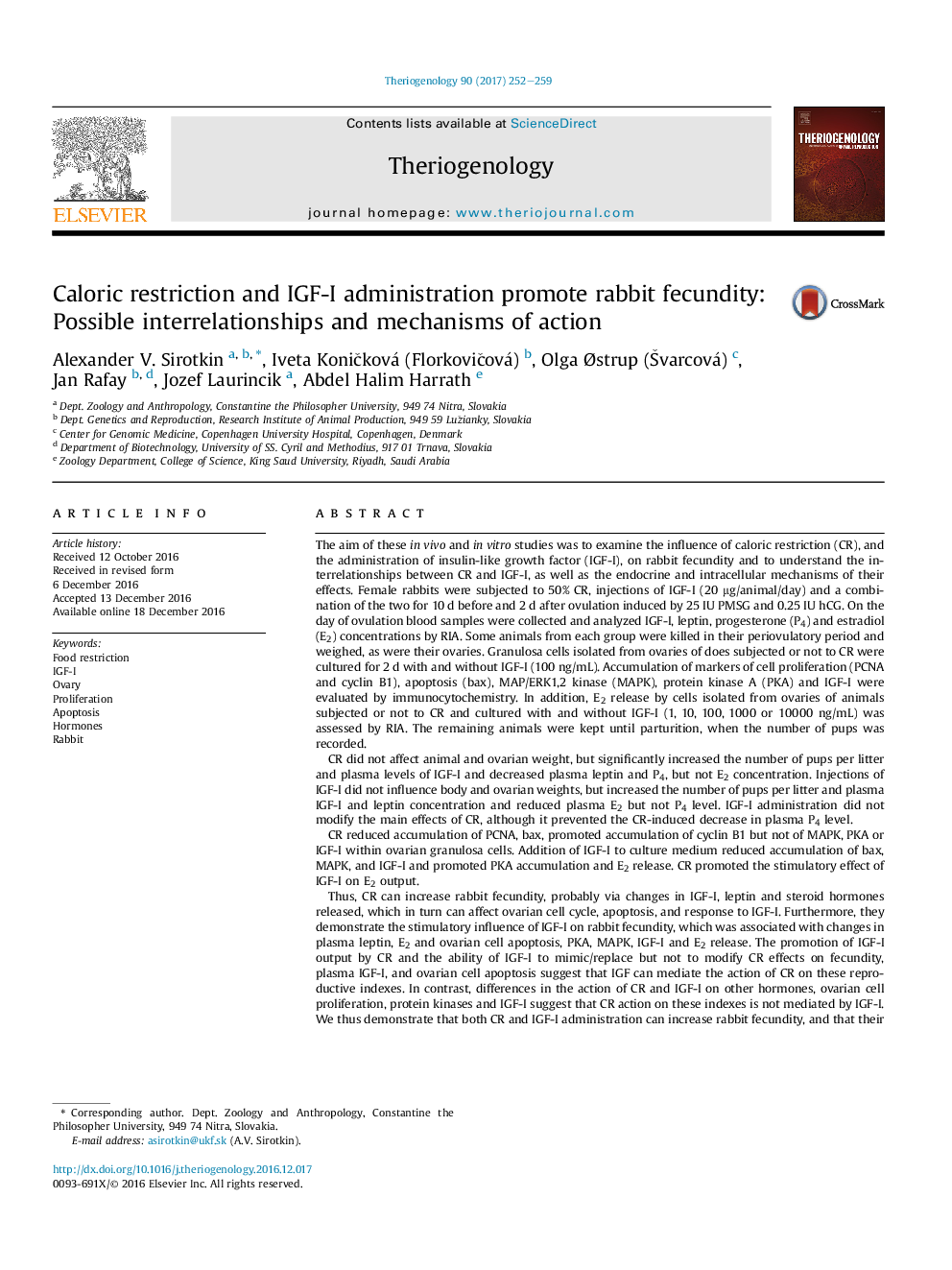| کد مقاله | کد نشریه | سال انتشار | مقاله انگلیسی | نسخه تمام متن |
|---|---|---|---|---|
| 5523143 | 1546079 | 2017 | 8 صفحه PDF | دانلود رایگان |

- Both caloric restriction and IGF-I administration can increase rabbit fecundity.
- Their effects can be mediated by reproductive hormones, ovarian cell proliferation and apoptosis.
- IGF-I can be mediator of some effects of caloric restriction.
The aim of these in vivo and in vitro studies was to examine the influence of caloric restriction (CR), and the administration of insulin-like growth factor (IGF-I), on rabbit fecundity and to understand the interrelationships between CR and IGF-I, as well as the endocrine and intracellular mechanisms of their effects. Female rabbits were subjected to 50% CR, injections of IGF-I (20 μg/animal/day) and a combination of the two for 10 d before and 2 d after ovulation induced by 25 IU PMSG and 0.25 IU hCG. On the day of ovulation blood samples were collected and analyzed IGF-I, leptin, progesterone (P4) and estradiol (E2) concentrations by RIA. Some animals from each group were killed in their periovulatory period and weighed, as were their ovaries. Granulosa cells isolated from ovaries of does subjected or not to CR were cultured for 2 d with and without IGF-I (100 ng/mL). Accumulation of markers of cell proliferation (PCNA and cyclin B1), apoptosis (bax), MAP/ERK1,2 kinase (MAPK), protein kinase A (PKA) and IGF-I were evaluated by immunocytochemistry. In addition, E2 release by cells isolated from ovaries of animals subjected or not to CR and cultured with and without IGF-I (1, 10, 100, 1000 or 10000 ng/mL) was assessed by RIA. The remaining animals were kept until parturition, when the number of pups was recorded.CR did not affect animal and ovarian weight, but significantly increased the number of pups per litter and plasma levels of IGF-I and decreased plasma leptin and P4, but not E2 concentration. Injections of IGF-I did not influence body and ovarian weights, but increased the number of pups per litter and plasma IGF-I and leptin concentration and reduced plasma E2 but not P4 level. IGF-I administration did not modify the main effects of CR, although it prevented the CR-induced decrease in plasma P4 level.CR reduced accumulation of PCNA, bax, promoted accumulation of cyclin B1 but not of MAPK, PKA or IGF-I within ovarian granulosa cells. Addition of IGF-I to culture medium reduced accumulation of bax, MAPK, and IGF-I and promoted PKA accumulation and E2 release. CR promoted the stimulatory effect of IGF-I on E2 output.Thus, CR can increase rabbit fecundity, probably via changes in IGF-I, leptin and steroid hormones released, which in turn can affect ovarian cell cycle, apoptosis, and response to IGF-I. Furthermore, they demonstrate the stimulatory influence of IGF-I on rabbit fecundity, which was associated with changes in plasma leptin, E2 and ovarian cell apoptosis, PKA, MAPK, IGF-I and E2 release. The promotion of IGF-I output by CR and the ability of IGF-I to mimic/replace but not to modify CR effects on fecundity, plasma IGF-I, and ovarian cell apoptosis suggest that IGF can mediate the action of CR on these reproductive indexes. In contrast, differences in the action of CR and IGF-I on other hormones, ovarian cell proliferation, protein kinases and IGF-I suggest that CR action on these indexes is not mediated by IGF-I. We thus demonstrate that both CR and IGF-I administration can increase rabbit fecundity, and that their effects can be mediated by changes in reproductive hormones, ovarian cell proliferation, apoptosis, and the response of ovarian cells to IGF-I.
Journal: Theriogenology - Volume 90, 1 March 2017, Pages 252-259